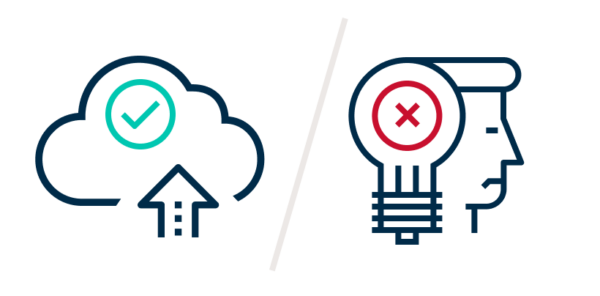Capabilities
share article
Migrating to a cloud ERP system offers many important benefits, from enabling automation and advanced analytics to speeding digital transformation. But actually realizing these benefits is easier said than done. As organizations rush to move to the cloud, there are inevitably desired capabilities that don’t make it into the first phase of implementation. The bells and whistles your teams have envisioned often don’t match reality, at least not out of the gate.
RGP’s Tolu Akin, Senior Director, Finance Transformation, says this bells and whistles gap can lead to buyer’s remorse — or at least disappointment. In this Q&A, Tolu discusses some of the issues to look out for — and how to proactively address them so that your cloud ERP migration delivers the expected business outcomes.
Q
Let’s start with why. What’s the reason for these gaps that you are seeing?
Tolu: With SAP sunsetting support for their legacy ECC systems, there’s a lot of concentrated demand for migration to SAP S/4HANA. System Integrator (SI) vendors often compete on fixed-bid contracts, limiting how much they can do, and they spread their best talent across many projects. The people who design and implement the system move on to their next project, leaving less experienced colleagues to resolve any issues.
SIs may start with what is called a technical release and then do a phased business release. It’s really a series of misaligned expectations about what is included at go-live and what gets phased in over time.
Q
Can we dig a bit deeper into the nature of this disconnect and how it might be resolved?
Tolu: The budget for the implementation usually lies with the IT organization, who is generally focused on clean technical code delivery for go-live with satisfactory user acceptance testing. That’s what they negotiate with the SI, and it’s usually a fixed-bid contract based on this set of deliverables. But the business stakeholders are not typically involved in the contract negotiations — the business gets the short end of the stick because they were never at the table.
“If you don’t have people with functional expertise and internal knowledge involved on the front end, you end up paying for it on the back end.”
– Tolu Akin, Sr. Director, Finance Transformation
Q
What business needs tend to get shortchanged?
Tolu: S/4HANA is a revolutionary change from the ECC structure. The new, cloud-based solutions are meant to streamline and replace on-premises solutions, which were expensive and highly customized. But these streamlined solutions require process improvements as well as change management and training so that system users can adopt the new ways of working.
 However, the SI doesn’t generally ask the business how they are doing things today, so no one documents the gaps between the as-is and the to-be processes, which creates gaps in the training content. Also, if you’re working on a fixed budget and fixed timeline, the training may get cut short. You may only show that person once, rather than investing the energy and change management needed to fully explain and reinforce that learning.
However, the SI doesn’t generally ask the business how they are doing things today, so no one documents the gaps between the as-is and the to-be processes, which creates gaps in the training content. Also, if you’re working on a fixed budget and fixed timeline, the training may get cut short. You may only show that person once, rather than investing the energy and change management needed to fully explain and reinforce that learning.
That’s where you see a lot of stabilization issues coming up, because the SI knows the solution is there and knows it works — but then you get what we call “green status, red face.” It’s working, but I’m not feeling like it’s working.
04.
What does a CFO or other finance decision-maker need to know when reviewing proposals and budget for a cloud ERP migration initiative?
Tolu: At times we use the word transformation loosely, but an SAP implementation really is a huge opportunity to transform. And to truly transform, you need your top talents leading the project.
In the office of the CFO, your focus is delivering budgets on time and doing financial analysis, so you may not be inclined to move your top finance and accounting talent from those functions to put them on an 18-month implementation project. But if you don’t have people with that functional expertise and internal knowledge involved on the front end, you end up paying for it on the back end. A problem that would have cost 50 hours of work becomes a 500-hour clean-up job.
Q
What can finance leaders do to address any shortcomings and start enjoying more of the bells and whistles they had anticipated?
Tolu: As with any big initiative, it’s best to start with the end in mind and set expectations for realistic business outcomes. This requires creating a comprehensive roadmap, assessing organizational readiness, and getting all of your stakeholders at the table from the get-go.
- Before: Many of the gaps and disappointments that emerge in the post-implementation/stabilization phase of a cloud ERP migration can be avoided or eased by planning for them before the implementation even begins, during what we call “phase zero.” This includes defining your target operating model and selecting the software that will best meet your needs.
- During: Don’t under-invest in change management and training. Free up your key functional people to contribute in a meaningful way so that there’s clear alignment between the technical release and business needs/expectations. And then be sure to give the business release as much love as the technical.
- After: Once you move into the optimization phase, you likely have a laundry list of additional capabilities you want to build into your solutions, such as business process improvements, enhanced reports or AI-enabled automation. And because you’re on a cloud solution, the software company releases new versions and updates, so your organization has to build the muscle to understand and prioritize those optimizations and continue to roll them out.

Wherever you are in your Cloud ERP journey, RGP can help.
Engaging with the right experts before, during and after implementation will yield exponential returns down the road. We’ve supported our clients with hundreds of successful ERP implementations, with services including project management, change management, business process design, and data migration, to name just a few. Want to learn more? Let’s talk.
Visit our Cloud ERP Resource Hub for free access to whitepapers, guides and other informative assets to help you make a smooth move to the cloud.





